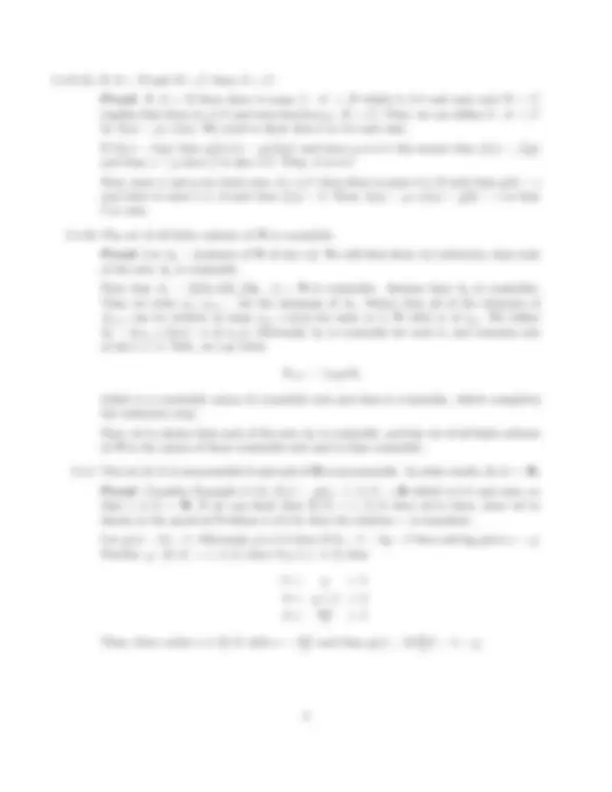



Study with the several resources on Docsity

Earn points by helping other students or get them with a premium plan


Prepare for your exams
Study with the several resources on Docsity

Earn points to download
Earn points by helping other students or get them with a premium plan
Community
Ask the community for help and clear up your study doubts
Discover the best universities in your country according to Docsity users
Free resources
Download our free guides on studying techniques, anxiety management strategies, and thesis advice from Docsity tutors
Material Type: Assignment; Professor: Moorhouse; Class: Real Analysis I; Subject: Mathematics; University: Colgate University; Term: Unknown 1989;
Typology: Assignments
1 / 2

This page cannot be seen from the preview
Don't miss anything!


Math 323 – Real Anlaysis – Homework Solutions
1.4.2 (a) If a, b ∈ Q then ab and a + b are in Q.
Proof: If a, b ∈ Q then we can write a = p/q and b = r/s with p, q, r, s ∈ Z. Since pr, qs ∈ Z, we have ab = pr/zs ∈ Q. Also ps + qr ∈ Z so a + b = ps+qsqr ∈ Q.
1.4.2 (c) No, I is not closed under addition or multiplication: For example,
√^2 ∈^ I^ but 2 + (−
1.4.4 inf{ 1 /n : n ∈ N} = 0 Proof: Obviously 0 is a lower bound of the set, so we need to show that the condition of Lemma 1.3.7 (the version stated in problem 1.3.2 (b)) is satisfied, i.e. for any choice of ≤ > 0 , there exists an element a ∈ { 1 /n : n ∈ N} such that 0 + ≤ > a. But the Archimedean Principle tells us that for ≤ > 0 given there exists some N ∈ N such that 1/N < ≤ and since a = 1/N ∈ { 1 /n : n ∈ N} we’re done.
1.4.7 Theorem 1.4.12. If A ⊂ B and B is countable, then A is either countable, finite or empty. Proof: Assume B is a countable set. Thus, there exists f : N → B, which is one- to-one and onto. Let A ⊂ B be an infinite subset of B. We must show that A is countable. Let n 1 = min{n ∈ N : f (n) ∈ A} n 2 = min{n > n 1 ∈ N : f (n) ∈ A} n 3 = min{n > n 2 ∈ N : f (n) ∈ A} ...
Notice that n 1 < n 2 < n 3 < ... so that nk = nm only if k = m. Now define g(k) = f (nk). We will show that g is one-to-one and onto. Obviously g is one-to-one, since f is one-to-one and if g(k) = g(m) then f (nk) = f (nm) so nk = nm and thus k = m. Now, let a ∈ A then a ∈ B, so there exists some n such that f (n) = a. But since f (n) ∈ A, then n = nk for some k and thus a = g(k).
1.4.9 Given sets A and B, A ∼ B if and only if B ∼ A. Proof: If A ∼ B then there is some f : A → B which is one-to-one and onto. Since f is onto, every b ∈ B is an image of some a ∈ A, i.e. f (a) = b. So we can define g : B → A by g(b) = a if f (a) = b. In other words, g = f −^1. The function g is well defined since f is one-to-one and g is onto since the range of g is equal to the domain of f. By a symmetric argument, if B ∼ A then A ∼ B.
1.4.9 (b) If A ∼ B and B ∼ C then A ∼ C.
Proof: If A ∼ B then there is some f : A → B which is 1-1 and onto and B ∼ C implies that there is a 1-1 and onto function g : B → C. Thus, we can define h : A → C by h(a) = g ◦ f (a). We need to show that h is 1-1 and onto. If h(x) = h(y) then g(f (x)) = g(f (y)) and since g is 1-1 this means that f (x) = f (y) and thus x = y since f is also 1-1. Thus, h is 1-1. Now, since f and g are both onto, if c ∈ C then there is some b ∈ B such that g(b) = c and there is some a ∈ A such that f (a) = b. Thus, h(a) = g ◦ f (a) = g(b) = c so that h is onto.
1.4.10 The set of all finite subsets of N is countable. Proof: Let An = {subsets of N of size n}. We will first show, by induction, that each of the sets An is countable. Note that A 1 = {{ 1 }, { 2 }, { 3 }, ...} ∼ N is countable. Assume that An is countable. Then we write an 1 , an 2 , ... for the elements of An. Notice that all of the elements of An+1 can be written as some ank ∪ {m} for some m ∈ N with m 6 ∈ ank. We define Sk = {ank ∪ {m} : m 6 ∈ ank }. Obviously Sk is countable for each k, and contains sets of size n + 1. Now, we can write
An+1 = ∪k∈NSk
which is a countable union of countable sets and thus is countable, which completes the induction step. Now, we’ve shown that each of the sets An is countable, and the set of all finite subsets of N is the union of these countable sets and is thus countable.
1.5.1 The set (0, 1) is uncountable if and only if R is uncountable. In other words, (0, 1) ∼ R. Proof: Consider Example 1.4.9, f (x) = (^) x 2 x− 1 : (− 1 , 1) → R which is 1-1 and onto, so that (− 1 , 1) ∼ R. If we can show that (0, 1) ∼ (− 1 , 1) then we’re done, since we’ve shown in the proof of Problem 1.4.9 (b) that the relation ∼ is transitive. Let g(x) = 2x − 1. Obviously g is 1-1 since if 2x − 1 = 2y − 1 then solving gives x = y. Further, g : (0, 1) → (− 1 , 1) since if y ∈ (− 1 , 1) then
− 1 < y < 1 0 < y + 1 < 2 0 < y+1 2 < 1
Thus, there exists x ∈ (0, 1) with x = y+1 2 and thus g(x) = 2(y+1 2 ) − 1 = y.